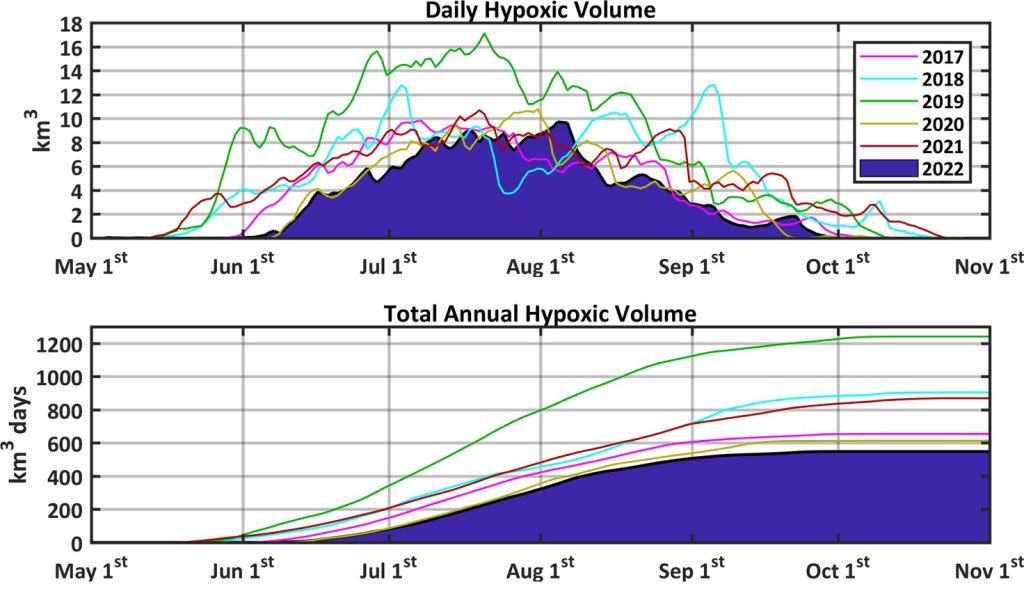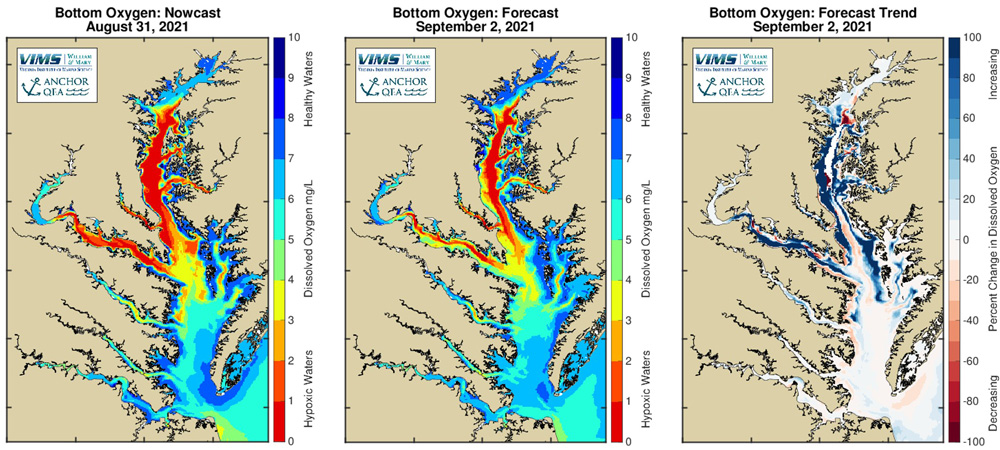2022 Chesapeake Bay Dead Zone Report Released
Chesapeake Bay, the largest estuary in the United States and the third largest in the world, is particularly vulnerable to human impacts. In recent decades, low dissolved oxygen and changing acidification have severely affected the Bay’s ecosystem. A dead zone—an area of water with little to no oxygen—can form when excess nutrients, such as nitrogen and phosphorous from fertilizer, wastewater, and urban runoff, enter the water. Scientists refer to these oxygen-poor waters as “hypoxic,” meaning the oxygen concentration is less than 2 milligrams per liter, which is too low for aquatic life to thrive.
In collaboration with the Virginia Institute of Marine Science (VIMS), Anchor QEA operates the Chesapeake Bay Environmental Forecast System (CBEFS) computer model, which both predicts dissolved oxygen concentrations and forecasts environmental conditions in the Bay every day. Anchor QEA and VIMS recently released a 2022 Chesapeake Bay Dead Zone Report that summarizes the severity of the dead zone during the summer of 2022 and compares these findings to data collected from 1985 to 2021, with a focus on the previous 5 years.

The report analyzes the daily hypoxic volume and total annual hypoxic volume compared to past years.
The Chesapeake Bay experiences hypoxic conditions every year, with the severity varying annually due to temperature, wind, and nutrient and freshwater inputs. The size of Chesapeake Bay’s dead zone often reaches its peak during summertime and has become one of the estuary’s major water quality concerns. There are multiple metrics used to compare the severity of hypoxia year to year, including the duration of hypoxia (days), total annual hypoxic volume (overall yearly severity of hypoxia), and maximum daily hypoxic volume.
The total annual size of the dead zone in 2022 was estimated to be smaller than 76% of those in the last 37 years. In 2022, cool and relatively windy spring conditions resulted in hypoxia beginning later than average (in June), and that was similar to the mild hypoxia of 2020. But as summer arrived, moderate winds allowed the levels of hypoxia to increase through the beginning of August, resulting in a daily maximum dead zone size similar to the average historical size (smaller than 54% of the last 37 years).

Because a small decrease in dissolved oxygen can significantly impact fish and other marine animals, researchers track the nowcast and forecast on the CEBFS computer model, as shown by these images forecasting the effects of passing remnants from Hurricane Ida in 2021.
In 2022, the amount of hypoxia quickly decreased from a maximum high in early August and continued a downward trend through early October. The quick decrease in hypoxia levels resulted from cooler temperatures and stronger winds in the Bay. Overall, the hypoxia in summer 2022 was short-lived, and the total annual level of hypoxia was relatively low, representing a relatively good year for hypoxic conditions in the Chesapeake Bay.
Looking back on 2022, a late onset of hypoxic conditions, followed by a rapid decline from a near-average daily maximum, resulted in relatively low total amount of hypoxia in the Bay. The health of Chesapeake Bay is complex, with the dead zones of the last few years being average to mild (excluding 2019, a year that had severe hypoxia). As notable weather impacts the levels of hypoxia in Chesapeake Bay, these real time forecasts of temperature, salinity, dissolved oxygen, hypoxic conditions, and harmful algal blooms help the community monitor the Bay’s health and facilitate safe, public access.

